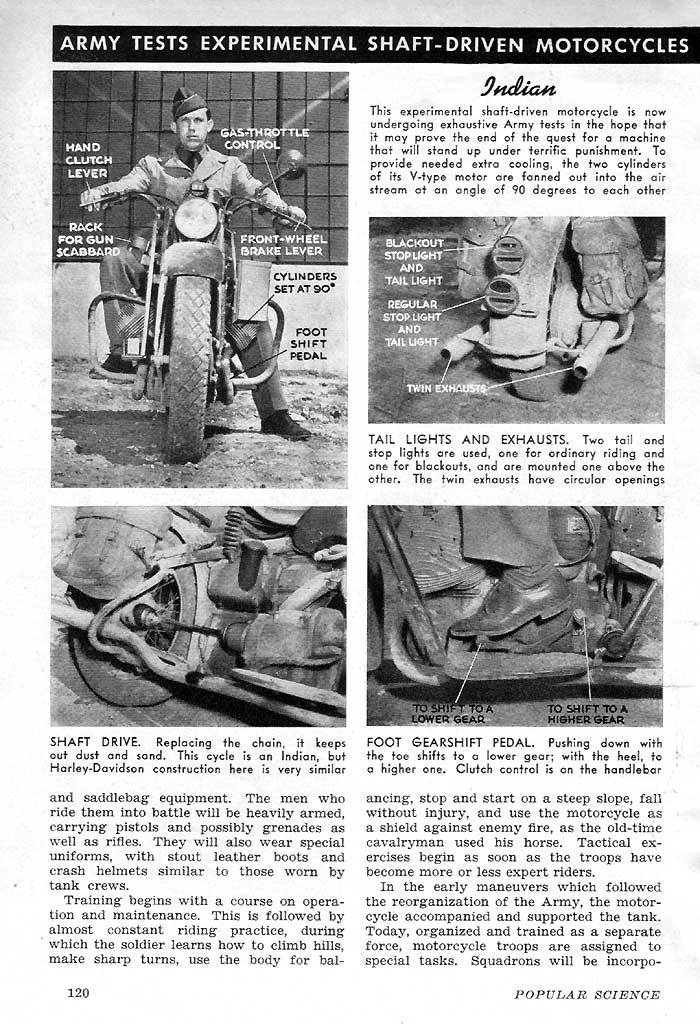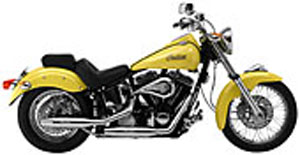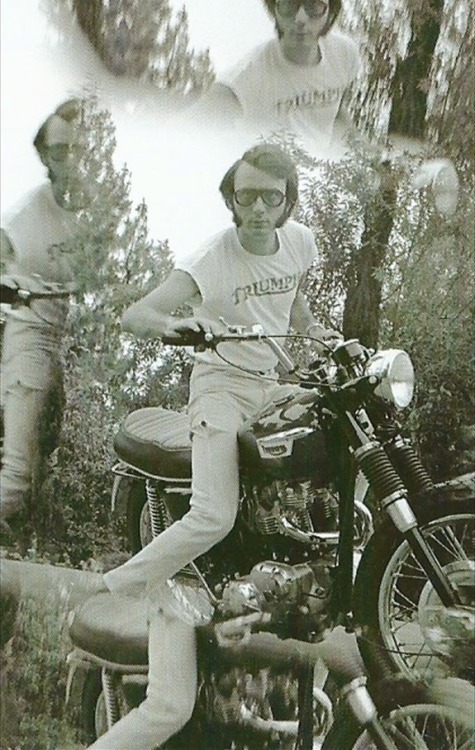

The end of WWII brought joy to the world except on Worthington Street in Springfield, Massachusetts. During The War, the US Army requested experimental motorcycle designs suitable for desert fighting. In response to this request, Indian designed and built the 841. Approximately 1,056 models were built. Approximately 1,054 would sit in the warehouse fighting off dust instead of Germans. The Indian 841 was tested by the Army, but even though the motorcycle was adopted for wider military use it was determined that the Jeep was more suitable for the roles and missions for which these motorcycles had been intended.
In 1945, a group headed by Ralph B. Rogers purchased a controlling interest of the company. On November 1, 1945, duPont formally turned the operations of Indian over to Rogers.
Under Rogers' control, Indian discontinued the Scout and began to manufacture lightweight motorcycles such as the 149 Arrow, the Super Scout 249, both introduced in 1949, and the 250 Warrior, introduced in 1950. Production of traditional Indians was extremely limited in 1949, and no 1949 Chiefs are known to exist.
The manufacture of all products was halted in 1953.
Continuing the trend, The Indian Motorcycle Company of America was formed from the merger of nine companies (yes, I said nine!), including manufacturer California Motorcycle Company (CMC) and IMCOA Licensing America Inc., which was awarded the Indian trademark by the Federal District Court of Colorado in 1998. The new company began manufacturing motorcycles in 1999 at the former CMC's facilities in Gilroy, California, better known as the "Garlic Capital of the World". The first "Garlic Indian" model, I mean "Gilroy Indian"model was a new design called the Chief (hmm, imagine that). Scout and Spirit models were also manufactured from 2001. These bikes were initially made with off-the-shelf S&S engines, but used the 100-cubic-inch (1,600 cc) Powerplus engine design from 2002 to 2003.
The Indian Motorcycle Corporation went into bankruptcy and ceased all production operations in Gilroy on September 19, 2003.






The first Yamaha FZR 1000 Genesis is presented
to a much-awaited public at the Cologne IFMA motorcycle show in Germany on September 18,
1986.
Yamaha continued the success of it's Supersport predecessors the RD 350 and RD
500. The FZR 1000 Genesis is considered a milestone model as it marked the transition from 2-stroke to 4-stroke Supersport motorcycles. This shift represented a new generation of high performance big bikes, which employed Yamaha racing technology from the track and in the process, changed people's lives forever.
However, truth be told, the FZR 1000 layout had already made its debut 2 years earlier.
The first YZF 750 Genesis endurance racer was entered at Suzuka 8h race and at
the Bol d'Or on the Paul Ricard track in France to "race proof" the "Genesis"
technology.




The man, the myth, the motorcycle, the series. "Then Came Bronson" debuts on television.
The first TV series to feature a motorcycle as one of the main characters. Previously, there had been series made with a dog (Lassie, 1954), a horse (Mr. Ed, 1958) and a car (My Mother the Car, 1965), but never a bike. Michael Parks starred as the protagonist, James "Jim" Bronson, a newspaperman who becomes disillusioned after the suicide of his best friend Nick (Martin Sheen, yes that Martin Sheen) and, after a heated argument with his editor, he had enough of "working for the man."
In order to try to cleanse his soul, Bronson becomes a vagabond, a nomad, searching for the meaning of life and seeking all of the experiences life has to offer. Mile after mile, he shares his values with the people he meets along the way and lends a helping hand when he can. Bronson drives a Harley-Davidson Sportster motorcycle and, as such, he was viewed by some as a romantic version of the solitary cowboy wandering the American west. The motorcycle had previously been sold to Nick by Bronson and after it is left at the suicide scene by his friend, Bronson buys it back from the widow.
Though the opening promises a journey of self-discovery, the premise of each episode is that Bronson enters someone else's life at a crucial point and acts as a catalyst for change. When Bronson encounters an Amish community, for example, a local boy becomes hot for the outside world and steals Bronson's motorcycle to run off to Reno, Nevada. Jim and a few biker friends track down the boy and cut off the fingers on his right hand (just kidding but, he should have). In another episode, located in Reno, Nevada, Bronson meets his cousin Eve on her wedding day and lends her money for the wedding service, but she runs off to the casinos and blows it. "Rotten whore." Jim curses.
Jim Bronson was committed to pacifism and often redirects an antagonist's anger into self-examination (similar to what David Carridine would do on "Kung Fu" three years later in October, 1972). Always, like a true catalyst, he rolls out of every episode unchanged.
The show was sometimes accused of being a knock-off of the movie Easy Rider, but the "Then Came Bronson" pilot actually preceded the release of that movie (TCB pilot-March 24, 1969, ER movie-July 14, 1969).
The first three episodes, including the end credits scenes, were shot in and around Jackson, Wyoming. The premier pilot movie was also shown at the town's then only theatre to give the locals a sense of what the series was about, since they were shooting in town and at many of the popular local spots.
Bronson's bike was a 1969 XLH 900cc Harley-Davidson Sportster.
The fuel tank is illustrated with the Eye of Providence, a.k.a. the All Seeing God or the Back of a Dollar Bill.





With higher ground clearance for use on poor quality roads, the Norton Model 16H (490cc side-valve) was first offered for military evaluation in 1932, together with a Model 18 (490cc) and a Model 19 (588cc ohv). The Norton designers began working with the War Office on a range of developments and modifications. The first evaluation Norton Model 16H was completed on September 16, 1935. Military orders were placed for the 16H (designated WD16H for War Department use) and by December of 1935 total military production was 308. Impressive number for only 3 months work. By December of 1936 it would be over 2200. The military orders for the 16H from 1936 throughout the course of the Second World War, set a ten-year record for the longest time the War Office procured a single make of motorcycle. The entire staff of the Norton factory in Bracebridge Street, Birmingham, were needed to meet demand - even the racing team found themselves on the WD16H production line. And often at the local for a pint of Tetley's.
A popular dispatch machine, the WD16H was also used for training, reconnaissance, convoy control and escort duties.
Pre war, the RAF ordered many hundreds machines with a non driven 'box' or Model G (person carrying) side-car. Military motorcycles left the Norton factory in Army Service green, Khaki green, Khaki brown or Olive green, depending on color specified at time of production. Prewar RAF machines (up to September 1939) were delivered in RAF Blue. Wartime RAF bikes were identically colored as the "Army" bikes. A number of machines were painted sand 'desert camouflage' by local workshops in the Middle East and used in Palestine and the North Africa Campaign.
********************
Also on September 16, 1991 Jay Leno crashes one of the 2,715 bikes he owns. Leno was riding his motorcycle along Mulholland Highway above Calabasas when the accident occurred about 11:30 a.m. Saturday, fire officials said.
According to wire service reports, Leno was making a U-turn to help another motorcyclist when he was hit by a third cycle, driven by Jeffrey Flaherty, 48, of Hermosa Beach.
Leno said Sunday that he swerved to try to avoid Flaherty's motorcycle. He cut and bruised his left leg, and was treated at Westlake Medical Center and released.
Jay Leno was not riding a Norton Model 16H.



In one of the most interesting, and to racing, important, days in motorcycle history, Ernst Eugen Wotzlawek defects to the West, taking MZ's tuning techniques to Suzuki, and winning Suzuki's first Grand Prix championship.
Ernst Degner arranged for his family to escape on the weekend he was racing in the Swedish Grand Prix at Kristianstad. In a race that could have secured the 125cc World Championship for himself and for MZ his engine suddenly failed early into the race. So, right after the race, Degner slipped out and drove to Gedser, Denmark where he caught the ferry to Holstein-Grossenbrode, West Germany. From there he continued on to Dillingen on the France/German border where met up with his wife and family who had already safely defected to West Germany a few days earlier.
When the MZ team had discovered his defection, the East Germans accused him of deliberately destroying his engine in the Swedish race and lodged a complaint with the FIM. The East Germans' accusations resulted in Degner's East German racing license being revoked. Degner had however acquired a West German racing license and with the help of Dr. Joseph Ehrlich, who owned EMC motorcycles, he was entered to ride a 125cc EMC at the Argentine GP. But, determined to keep him out of the race, the East German government pricks sent cables to the carriers of the bike that resulted in the machine being delayed on its journey to Argentina. Ernst was thus prevented from racing in the final 125cc World Championship round in Argentina. Months later, a FIM court in Geneva, Switzerland, dismissed MZ's complaint against him.
In November of 1961 Degner moved to Hamamatsu, Japan to work for Suzuki racing. Using the specialist two-stroke knowledge he had gained at MZ, he designed Suzuki's new 50cc and 125cc racers.
In 1962 Ernst Degner won Suzuki's first World Championship in the 50 cc class.
Degner, Ernst Degner.


At Autodromo Nazionale Monza, Geoff Duke thrills the home crowd, winning the 1954 Nations Grand Prix (Italian Grand Prix) aboard his 500cc Gilera.
Duke continues his dominance that began on a Norton winning both the 500cc and 350cc World Championship in 1951 and the 350cc World Championship in 1952. Switching to Gilera in 1953 he would win the 500cc World Championship in '53, '54 and '55.
Also today in motorcycle history, September 12, 1966, the Triumph-riding, wool hat-wearing Michael Nesmith and his "pals" Davey Jones, Peter Tork and Mickey Dolenz debut on American television as 'The Monkees'. At the auditions in October of 1965 Nesmith wears a wool ski-hat 'to keep the hair out of his eyes' while riding his Triumph Trophy. The producers gave him the nickname "Wool Hat", realizing how dumb that sounds they dropped it after the pilot but, kept the hat.





For the third time in nearly four years, Charles Fehn applies for a patent for his Rokon Trail-Breaker motorcycle.
The tale of the Trail-Breaker two-wheel-drive motorcycle can be traced back to 1958 in San Bernardino, California, when Charles Fehn began work on his invention, a "Motorcycle for slow cross-country travel over obstructions and in mountainous regions, and over snow and soft ground". A bit of a long-winded title but, it was the birth of the Trail-Breaker.
Charlie applied for his first patent on April 13, 1959. No go. His second application, abandoned like the first, came on August 31, 1962. It wasn't until his third patent attempt, now trimmed down to "Motorcycle having two driven wheels", filed August 20, 1963, that Charlie would finally get his patent. By the date of the third filing, the bike was in full-fledged production but, yet it would be August 23, 1966 before the patent would be granted.
Many myths follow the story of who solved the Trail-Breaker's original steering problem. Well, I'm here to tell you that contrary to popular belief, it was Fehn who solved the steering problem (inherent in a two-wheel-drive motorcycle) by developing a driveline over-ride mechanism. He developed the over-ride clutch and incorporated it into the original patent but, the early mechanism used a complex ball-bearing-on-ramp system (a bit Rube Goldbergesque), so it was simplified in 1962 to a one-way spring-on-collar device, which is basically the same over-ride spring assembly that is still in production today. This one-way clutch allows the front wheel to travel faster than the back wheel, but not vice-versa. This is what allows you to turn corners without having bike and body driven to the ground, the result of having both wheels turning the same speed when the front wheel needs to travel farther in a corner. Another of his patents was the hollow aluminum wheel, which holds 4.5 gallons of liquid ballast or fuel. Conversely, with the wheels empty, the bike can be thrown into a body of water and will float just fine enabling you to date Kelly Mathewson at the camp across the pond. Two ingenious ideas, one great motorcycle, the Trail-Breaker.



























